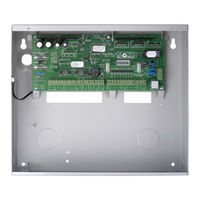Bosch CC880 Manuals
Manuals and User Guides for Bosch CC880. We have 2 Bosch CC880 manuals available for free PDF download: Installation Manual, Operator's Manual
Bosch CC880 Installation Manual (130 pages)
Brand: Bosch
|
Category: Control Panel
|
Size: 1 MB
Table of Contents
-
Bell Test29
-
Strobe Test29
-
Event Codes34
-
Securitel38
-
Ring Count49
-
User Codes50
-
Code Retries52
-
Zone Types55
-
Zone Options56
-
Day Alarm57
-
AC Fail60
-
Low Battery61
-
Sensor Watch61
-
Entry Time73
-
Exit Time73
-
System Date74
-
AWAY Mode84
-
17.0 Diagrams103
-
18.0 Appendices113
-
Printer122
Advertisement
Bosch CC880 Operator's Manual (32 pages)
Brand: Bosch
|
Category: Security System
|
Size: 0 MB
Table of Contents
-
-
18 Testing
13 -
20 Day Alarm
13
Advertisement

